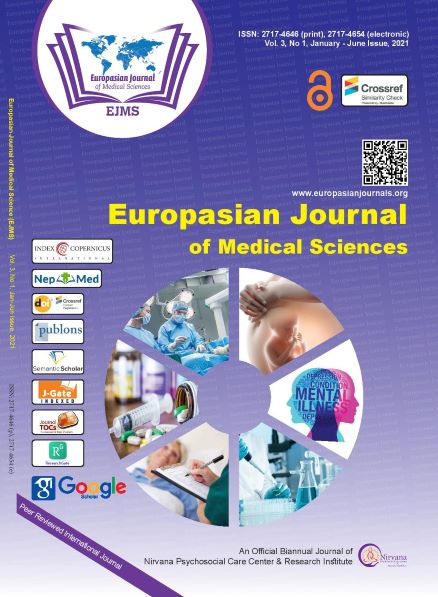Clinicopathological, Endoscopic and Radiological Evaluation of Intestinal Tuberculosis among Nepalese Patients at a Tertiary Care Center
Abstract
Background: Intestinal tuberculosis is often difficult to diagnose due to its insidious
onset and nonspecific and protean manifestations. Delay or failure of diagnosis
is associated with significant complications like perforation, abscess, fistula and
strictures. The objective of the study was to provide a descriptive analysis of clinical,
endoscopic, radiological and pathological findings in these patients.
Methods: A prospective study including 52 hospitalized patients was done between
April 2018 to 2020 at Tribhuwan University Teaching Hospital. Statistical analyses
were done by Microsoft excel version 16.
Results: Males were 63% while females were 37 %. The average age was 37 years.
84% had abdominal pain followed by abdominal distension (50%), chronic diarrhea
(51%) and cough (21%). Abnormal chest X-Ray was found in (37%) among whom
(53%) had sputum positive for tubercular Bacilli. Common CT scan findings were
thickening and heterogenous enhancement of bowel loops (79%), lymphadenopathy
(56%) and ascites (44%). Endoscopically, commonly involved sites were terminal
Ileum (95%), cecum (77%) and ascending colon (42%). Frequent finding were ulcers
(83%), patulous and deformed Ileocecal valve (33%), mucosal nodularity (38%),
hypertrophic mucosa (21%) and strictures (11%). Biopsies revealed granulomas in
(77%) specimens. (65%) of them had central caseous necrosis. Among 10 subjects
undergoing needle aspiration of lymphnodes, (70%) had central caseous necrosis.
Those with coexisting peritoneal involvement had a mean ascitic fluid adenosine
deaminase level of 73 ± 8 IU/L.
Conclusion: Intestinal tuberculosis remains a major concern in developing countries.
A composite analysis of the clinical manifestations, CT scan, endoscopic findings and
pathological examination of the biopsies aid in making a proper and timely diagnosis
so as to prevent complications and mortality.
Copyright (c) 2021 Authors

This work is licensed under a Creative Commons Attribution 4.0 International License.
All articles published in EJMS are licensed under the Creative Commons Attribution 4.0 International License (CC-BY 4.0). The author/s as the copyright holder will retain the ownership of the copyrights without restrictions for their content under the CC-BY 4.0 license, and allow others to copy, use, print, share, modify, and distribute the content of the article even in commercial purpose as long as the original authors and the journal are properly cited. No permission is required from the author/s or the publishers. Appropriate attribution can be provided by simply citing the original article.
On behalf of all the authors, the corresponding author is responsible for completing and returning the agreement form to the editorial office. More information about the terms and conditions, privacy policies, and copyrights can be found on the webpage of the Creative Commons license privacy policy. https://creativecommons.org/licenses/by/4.0/




